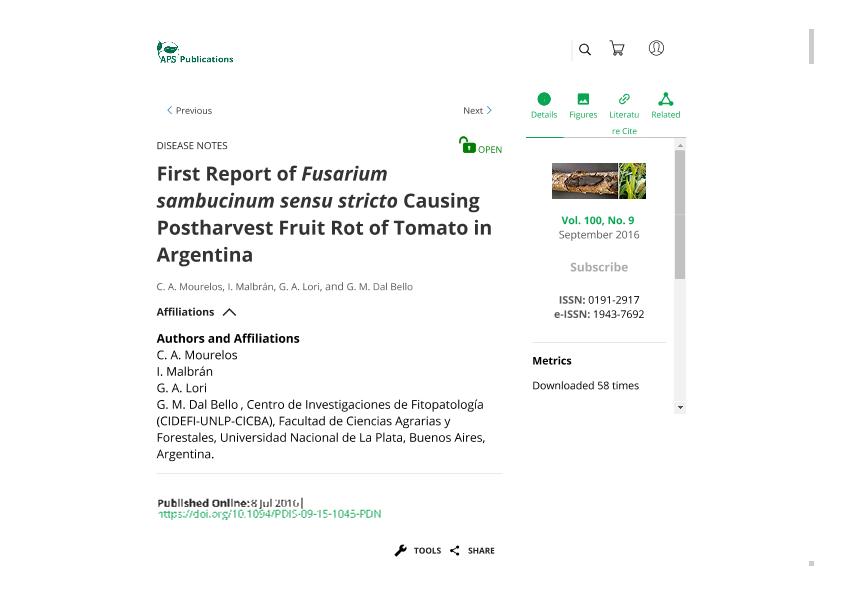Artículo
First report of Fusarium sambucinum sensu stricto causing postharvest fruit rot of tomato in Argentina
Fecha de publicación:
09/2016
Editorial:
American Phytopathological Society
Revista:
Plant Disease
ISSN:
0191-2917
e-ISSN:
1943-7692
Idioma:
Inglés
Tipo de recurso:
Artículo publicado
Clasificación temática:
Resumen
Tomato (Solanum lycopersicum L.) is among the most important horticultural crops in Argentina. The green belt area surrounding the city of La Plata (Buenos Aires, Argentina) represents around 30% of the horticultural production of the province. Annually, an average of 408 ha of tomato is harvested in this region, of which 70% is for fresh consumption and 30% for processing. During the summer of 2013 to 2014, postharvest fruit rot was found in 20% of the storage facilities from the horticultural area of La Plata on fresh market tomato fruits cv. Elpida. Symptoms started as small circular lesions of watery aspect that increased in size over time. Lesions destroyed subepidermal tissue, causing ruptures in the epidermis and the emergence of abundant white mycelium. Fruits would eventually collapse. Surface disinfested pieces of symptomatic fruit were placed on potato dextrose agar (PDA) medium and incubated at 23 ± 2°C with a cycle of 12/12 h light/dark for 9 days in a growth chamber. Fusarium colonies with abundant white mycelia and ruby red pigments, which reached 5.1 cm in diameter in 4 days of growth, were obtained. A single conidia culture was originated of each isolate. Abundant curved, slender, 3 to 5-septate macroconidia with a constrained and pointed apical cell (3-septate: 30 to 45 × 4 to 5 µm; 5-septate: 40 to 53 × 5 µm), and a foot-shaped basal cell were produced from monophialides. Microconidia were not observed and chlamydospores were produced both singly and in chains. According to these morphological characters, the pathogen was identified as Fusarium sambucinum Fuckel sensu stricto (Nirenberg 1995). Identification was confirmed by sequencing of internal transcribed spacer (ITS) (White et al. 1990) and translation elongation factor (TEF) 1-α (O’Donnell et al. 1998) genes. Identities of the resulting sequences (accession nos. KX023900 and KX023899) were confirmed using BLAST analysis in the NCBI database. Analysis revealed 99% identity with F. sambucinum (Gibberella pulicaris isolates F153N10 and IBT1744). Similar symptomatology is induced by this fungus in potato, causing significant yield losses (Secor and Sala 2001). To fulfill Koch’s postulates, pathogenicity tests were conducted for the three isolates obtained. Symptomless tomato fruits from cv. Elpida were disinfected in 5% NaOCl, rinsed with sterile distilled water, and inoculated with macroconidia from pure cultures of the isolates using a sterile needle. A control treatment was inoculated with sterile water. After inoculation, fruits were placed in a sterile plastic container and incubated for 24 h in a moist chamber and then at 23 ± 2°C in a growth chamber. Each fruit constituted a single replicate and each treatment was replicated five times. All inoculated fruits showed symptoms identical to those observed in the field 5 days after inoculation. The control-inoculated fruits did not show symptoms of infection. F. sambucinum was reisolated from symptomatic fruits, confirming Koch’s postulates. To our knowledge, this study constitutes the first report of F. sambucinum causing symptoms of postharvest soft rot in tomato fruits in Argentina.
Palabras clave:
Tomato
,
Fusarium Sambucinum
,
Rot
Archivos asociados
Licencia
Identificadores
Colecciones
Articulos(CCT - LA PLATA)
Articulos de CTRO.CIENTIFICO TECNOL.CONICET - LA PLATA
Articulos de CTRO.CIENTIFICO TECNOL.CONICET - LA PLATA
Citación
Mourelos, Cecilia Alejandra; Malbrán, Ismael; Lori, Gladys; Dal Bello, Gustavo; First report of Fusarium sambucinum sensu stricto causing postharvest fruit rot of tomato in Argentina; American Phytopathological Society; Plant Disease; 100; 9; 9-2016; 1952
Compartir
Altmétricas




